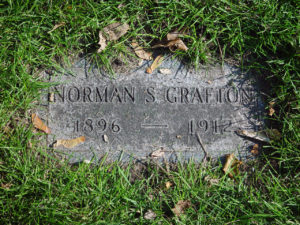By Sue Hunter Weir
There are 139 drowning victims buried in Minneapolis Pioneers and Soldiers Cemetery. A handful of them were intentional””people who committed suicide by drowning””but the majority of the drowning deaths were accidental. Many of those victims were boys or young men.
Although Minnesota prides itself on being the land of 10,000 lakes, it is the Mississippi River that holds the greatest attraction for many kids doing what kids do in the summertime: fishing, swimming, just fooling around. The headlines for stories about boys who drowned, described the boys as “venturesome” or “adventurous,” and often spoke of the river “claiming” the boys. Given the attractions and opportunities that the river held for boys, the idea that the river claimed them seems particularly fitting.
The cemetery”'s first recorded drowning was that of an unknown child. He is identified in the cemetery records only as “Unknown German Boy,” but how those who found his body knew that he was German is something of a mystery. This unnamed child drowned in August 1862 but there is no further information about his age or about where he drowned although, given how early it was in the city”'s history, the river seems the most likely place. He was never claimed although surely someone must have missed him.
Venturesome boys could, and did, drown in lakes and ponds but there was no place that could compare to the Mississippi River. It was not only a body of water, but it was really big water that moved quickly. And there were any number of interesting things to be found floating in the river or washed up on the riverbank. There were bridges, booms, and barges, ideal places for having adventures with your friends. The boys had a handful of favorite places to play and those places were very dangerous.
On June 26, 1890, nine-year-old Otto Nelson and his friend went swimming by the railroad”'s short-line bridge on the Mississippi River. Otto wasn”'t really swimming since he didn”'t know how, but that didn”'t keep him from diving from a rock into the river where he quickly sank. His friend tried to save him but couldn”'t. Less than a month later, on July 22, 1890, ten-year-old Emil Berglund drowned at the same location. He drowned after he slipped from a boom and fell into the river. Five years later, on July 22, 1895, nine-year-old John Carlson was fishing at the short-line bridge when he fell from the boom and was swept away by the current.
The water wasn”'t particularly deep by the bridge although it was well over the heads of young, or even teenage, boys, but the current was too strong for those who fell in to fight against it and win. Seven years later, another boy, 13-year-old George Belland was swimming near the railroad”'s short-line bridge when he was pulled under by the current and drowned.
Another place that the boys liked to play was under the Tenth Avenue Bridge. On July 15, 1893, eight-year-old Clayton Freese was swimming under the bridge when he drowned. On November 6, 1906, Carl Johnson and some of his friends were playing on a barge that was docked under the bridge when he slipped into the water. E. E. Myers, an employee of the power house, dived into the water fully dressed and made a heroic effort to save Carl but his heavy wet clothes began to drag him down and he lost his hold on Carl.
City officials did what they could to try and keep boys from swimming in dangerous waters. In 1905, the city created the Gerber Baths on what was formerly known as Hall Island. The bath, which was named after one of the city”'s aldermen, was established with the expressed purpose of saving boys”' lives. The Minneapolis Journal reported that girls were “not in the habit of getting drowned in the river and [since] the chief object of the baths was to save the boys,” girls were limited to using the bathhouse two half-days a week. Judging from cemetery records, it appears that providing a safer place to swim may have saved at least some boys”' lives.
There is only one boy buried in Minneapolis Pioneers and Soldiers who drowned in the Mississippi River after 1905. He was seven-year-old Herbert Wennerlund, who died on May 18, 1907.  Two of his young friends witnessed the drowning but were so frightened that they made a pact not to tell anyone, including their parents, what they had seen. It was only after Harold”'s father came looking for his son that they confessed and Harold”'s body was recovered.
These adventurous boys who were claimed by the river are buried in various locations throughout the cemetery.










